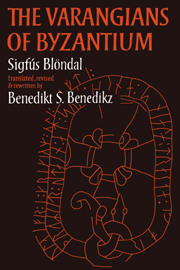Book contents
- Frontmatter
- Contents
- Illustrations
- Preface
- 1 Varangians and their origins
- 2 The army and navy of the High Byzantine Empire
- 3 Norse and Russian forces in the Byzantine army to the death of Romanos III
- 4 Haraldr Sigurðarson and his period as a Varangian in Constantinople, 1034–1043
- 5 The Varangians between 1042 and 1081
- 6 Varangians during the period 1081–1204
- 7 The ghost of the regiment: Varangian evidences 1204–1453
- 8 The Emperor, his Court, his guards and his city
- 9 Some individual Norse and English Varangians and travellers to Byzantium
- 10 Runic inscriptions concerning Varangians
- Select bibliography
- Index
4 - Haraldr Sigurðarson and his period as a Varangian in Constantinople, 1034–1043
Published online by Cambridge University Press: 19 October 2009
- Frontmatter
- Contents
- Illustrations
- Preface
- 1 Varangians and their origins
- 2 The army and navy of the High Byzantine Empire
- 3 Norse and Russian forces in the Byzantine army to the death of Romanos III
- 4 Haraldr Sigurðarson and his period as a Varangian in Constantinople, 1034–1043
- 5 The Varangians between 1042 and 1081
- 6 Varangians during the period 1081–1204
- 7 The ghost of the regiment: Varangian evidences 1204–1453
- 8 The Emperor, his Court, his guards and his city
- 9 Some individual Norse and English Varangians and travellers to Byzantium
- 10 Runic inscriptions concerning Varangians
- Select bibliography
- Index
Summary
Haraldr Sigurðarson, later King Harald III (Hardrada) of Norway, is without question the best-known of the Norsemen who entered the Imperial service as a Varangian. As the younger half-brother of King Olaf II (St Olaf), Haraldr spent the years following his brother's dethronement and death in exile in various parts of the world. Immediately after the débâcle at Stiklestad, his wounds having been healed at a remote farm in East Norway, Haraldr made his way via Sweden to Kiev, where he clearly held some kind of military post. The statement in Heimskringla that he ‘became commander over the King's [Jaroslav's] defence army’, is so obvious an exaggeration as to be nonsensical, but equally clearly Jaroslav would have been pleased enough to make use of this young warrior and, in view of his royal lineage, would give him some kind of subordinate officer's rank. It is also perfectly reasonable for him to have been employed on the arduous þólútasvarf, as well as border warfare such as Snorri Sturluson attributes to him from a verse by the poet þjóðólfr Arnórsson about the other Norse commander in the service of Prince Jaroslav, Eilífr Rögnvaldsson.
Eitt höfðusk at
Eilífr þars sat,
Höfðingjar tveir;
Hamalt fylktu þeir;
Austrvindum ók
Í ongvan krók,
Vasa Læsum léttr
Liðsmanna réttr.
One thing two lords did (Eilifr was there); they set their men in a circle of shields; the East Wends were hard pressed; the soldiers made the rights of the Læsir hard to get.
- Type
- Chapter
- Information
- The Varangians of Byzantium , pp. 54 - 102Publisher: Cambridge University PressPrint publication year: 1979



